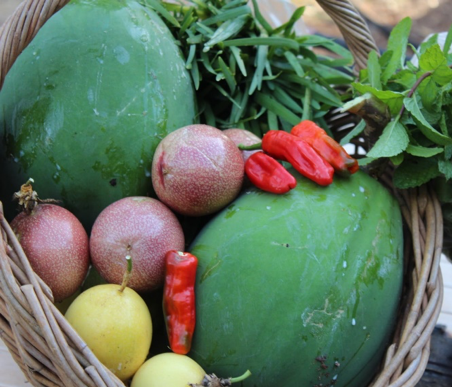April: What are we going to eat today?
What are we going to eat and drink today?
The links below will take you to an interesting short video about two ordinary householders and their journey from awareness of recycling to food independence.
“Growing your own food is more than a passing trend. It is fast becoming a necessity. Come join us at Rosie and Peter's Assagao Kitchen Garden and Food Forest. Pop over to Eco Champions For Goaa beautiful example of how each one of us can achieve food independence in our own backyards.”
There is a section of the video I have transcribed below that I found worth thinking about … Rosie summarizes the situation we are all in in relation to our food and nutrition——
“For me now, getting up, jumping in the car, going to the supermarket, picking stuff up, getting rid of packaging, storing in the refrigerator is the whole opposite of convenient.
I want to pick up my basket, walk out the door and come back with a minimum of 20 species and the nutrient diversity that represents, sometimes I’ll eat it straight off the bush. I’ll literally walk through the garden grazing. By the time I’m done, I’m done, no washing up, no storage. That is true convenience.”
Peter describes how they started by segregating their garbage, then composting food waste, seeds start to grow from the compost heap and the food garden takes off from there.
It can be that simple. It takes a little bit of effort, keeping kids and dogs out of the compost, putting on some mulch and watering enough to keep it damp. That little bit of effort is worthwhile when you want chillie or greens or (it’s nearly time) fresh tomatoes at your back door ready to eat when you want them.
So many fruit trees grow like weeds in our climate, Guavas fruit all year round, custard apples love the water from the washing machine and fruit continuously, limes also love a bit of soapy water as do bananas. Pawpaw (Papaya) like to grow out of the compost pile especially if there are some fish waste in the pile.
Hopefully the cooler weather is coming and now is the time to plant seeds and prepare garden beds.
If you have raised beds it is useful to plant lemon grass or vetiver or even pigeon peas around the outside edge as Sharon Gavranich has done in the picture below.
This not only softens the surrounding soil and conserves water around the bed but also insulates it from the heat. Once the planting have reached the same height as the bed they can be ‘chopped and dropped’ for mulch in the bed.
Another useful technique in preparing beds for planting is to soften and level the soil and then overlay the bed with the soft leaves of plants like moringa or any rain tree. Then overlay them with lemon or vetiver grass or straw. So, when it comes time to plant out seedlings the ‘bed’ is ready and mulsh is already in place and the seedlings can be slipped in easily.
I have heard on the ‘passionfruit vine’ that the Shire may be interested in re-thinking waste collection and re-cycling. Food waste re-cycling for compost is my particular passion, if there are readers interested in participating in food waste recycling or having their food waste collected for compost it would be great to hear from you.




